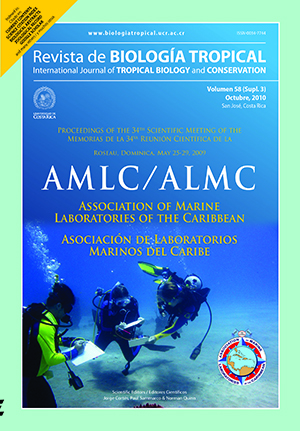Abstract
The Gulf of Cariaco is a marine ecosystem with high primary productivity, which gives it an ecological and socioeconomic importance. Nevertheless, anthropogenic activities around the Gulf produce wastes that are deposited directly or by runoff into the sediments, and consequently, increases concentrations of metals in this ecosystem. The objective of this study was to determine the distribution of cadmium, copper, lead, manganese, nickel and zinc in geochemical fractions of surface sediments, using modified BCR sequential extraction procedure. The concentrations were measured using flame atomic absorption spectroscopy. In addition, the contents of soluble and exchangeable metals associated to carbonate fractions, determined by BCR, were compared with those determined by the method of Campanella. Samples were collected in 12 stations during June 2007. The applied methodologies were evaluated with a certified reference material of marine sediments (HISS-1) and the results indicated that these methods provide adequate accuracy and precision for the extraction of metals. The total metal concentrations (μg g-1) were, Cd: < limit of detection (LD)-5.0; Pb: 1.79-60.41; Cu: no detected (ND)-42.18; Zn: 25.13-104.57; Mn: 66.31-80.29 and Ni: 3.29-24.58. Cd, Cu, Ni and Pb at several stations, exceeded the Canadian Sediment Quality Guidelines of the Lowest Effect Levels (LEL). Cadmium was identified as being the most mobile of the elements, having the highest concentrations in soluble and exchangeable cations and carbonates. However, Pb, Cu, Mn and Zn levels were found highly associated to organic matter and sulfide fractions. The methods did not show significant statistical differences for the extraction of soluble and exchangeable cations and the metals associated to carbonate fraction. There are several significant correlations between heavy metals, which suggest their common origin.
##plugins.facebook.comentarios##

This work is licensed under a Creative Commons Attribution 4.0 International License.
Copyright (c) 2010 Revista de Biología Tropical
Downloads
Download data is not yet available.






